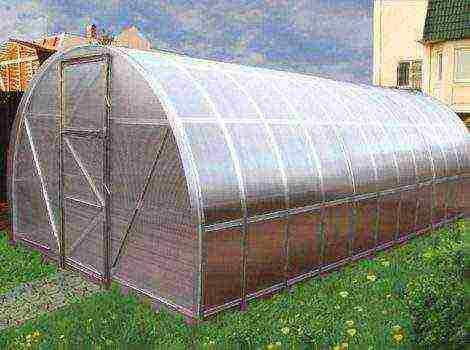Content
- 1 Popular ways to plant and grow tomatoes
- 2 Advantages and disadvantages of the method
- 3 Features of the method
- 4 Growing methods
- 5 Using germinated seeds
- 6 Using dry seeds
- 7 Substrate use
- 8 Some helpful tips
- 9 The method of growing tomatoes from Galina Kizima
- 10 Potato growing method from Galina Kizima
- 11 The method of growing carrots from Galina Kizima
Growing tomatoes according to the method of galina kizima
A. A. Kazarin, an experienced gardener from Pskov with 40 years of experience.
"Prohibition" for tomatoes
It has become a familiar picture when summer residents, having arrived at their garden plots on weekends, first of all rush to the greenhouses with a watering can to water the tomatoes. This occupation, especially for the elderly, is quite exhausting, the return in the harvest for this diligence is most often scanty.
It is a pity for people engaged in completely useless and even harmful work. Therefore, at every opportunity (in print, on the radio, at meetings with gardeners), you have to talk about your method of growing tomatoes without watering. This method has no analogue in the world.
At one time, due to lack of funds, I could not apply for a patent for an invention and limited myself to publication in print (the newspaper "Dachniki" No. 3, 1994, article "A life-lover will not be lost") The essence of the method is as follows. With periodic watering (at least rarely - once every one to two weeks, as most gardeners usually do), there is no stimulus for growth at the roots of a tomato, until the beginning of fruiting: moisture and nutrients for the development of the stem and leaf surface in the absence fruit is enough.
The roots begin to grow only from the moment of mass fruit setting, that is, with a significant delay. As a result, fruiting is delayed, and the yield is reduced.
In the absence of watering, the roots begin to look for moisture long before the beginning of fruiting, grow in all directions, a powerful root system develops in a timely manner, capable of fully nourishing the plant not only during the growth of the stems, but also during the period of fruit filling. In this case, the yield is always higher than that of plants with watering. Of course, not everything is as simple as it seems at first glance.
With normal planting, especially in greenhouses and in hot dry weather, the plants may not survive and die. But this is a rare exception. Let's conduct an experiment like this.
Cut off some kind of shoot from a tomato plant, for example, a stepson, and embed it in the soil by half the stem, pour water on top to compact and moisten the soil. This stem will not dry out, over time it will give roots and will develop normally. From what?
Yes, because the stem itself (its buried part), when planting, replaced the functions of the root. This means that you need to make fuller use of this biological feature of the tomato when growing it. What I am doing.
Tomatoes without watering
When planting seedlings from its lower half, I break off all the leaves, dig an oblong groove-hole slightly more than half a stem long under the bush. I pour half a bucket-bucket of compost into the groove (I prepare the compost without sprinkling its layers with mineral fertilizers, so I put it as needed, without fear of overfeeding), a handful or two of wood ash, 1 gram of potassium permanganate.
Mix everything thoroughly. I pour half a bucket of water into the grooves. After absorbing moisture, I lay the lower part of the stem strictly horizontally, orienting the tops to the north.
If I plant seedlings without a clod of earth, then I definitely breed a clay chatterbox, dipping half a stem in it, then dusting the coating with dry earth (for better connection with the soil). Sprinkle with a layer of earth 3-5 cm.
I tie the upper-nude part of the stem almost at a right angle to the stakes driven in there and then (or later I tie it to the trellis). From above I pour another half a bucket of water under the bush, trying to avoid moisture getting on the leaves.
That's all - I don't water the bushes anymore throughout the season, right up to harvest. It should be remembered that if you plant the plants deeper, then you will not get the effect of planting, since at a depth of 10-15 cm microorganisms are practically absent, and they mainly feed the plant. The first time after planting the plants are pleasing to the eye, almost never wither in the sun.
But after that, when drying in the holes of the earth, you see how the leaves of the tomatoes shrink slightly. I just want to water them at this time. And a caring vegetable grower here, of course, cannot stand it - it gives the plants moisture. And in vain.
After all, what happens to the appearance of a plant is quite natural. When the soil dries up, there is a struggle for survival in it. The plant seeks moisture, the roots grow vigorously, energy is expended on this, plastic substances, which at this time are not yet fully replenished.
But a little time will pass, the tomatoes will get stronger, your pets will come to life and become pleasing to the eye. The value of the technique I propose is that it allows you to grow a good harvest even from the most seemingly unusable seedlings - frail or overgrown.
After 2-3 weeks, any "dead" seedlings become like a palm tree. It is only necessary for their owner to overcome a difficult psychological barrier and refrain from watering. Tomatoes without watering can be grown on any type of soil at any level in the area of groundwater.
Sometimes in some greenhouses with muddy soil, the earth dries up and turns into dust. In such places, even the weed dries up. Here sometimes, about once a month, you still have to keep the planted plants with moisture.
In general, if you want to get the maximum yield of tomatoes, then you can start watering them no earlier than at the time of mass setting of fruits, when the plant has already basically formed the root system. But I still don't water them, otherwise the fruits become watery and less tasty.
And even without this, there are so many tomatoes that we process them only for juices, and there is enough prepared for the family for the whole year until the next harvest. Since the publication of the method, I have received many grateful letters. Foreigners are also showing interest in it. "Kazarin Method", "Ancestral Land", No. 3, March 2013
Tomatoes without watering
Personal experience of Galina Donova from Krasnoyarsk I have always been embarrassed by the large labor costs in the garden. In an effort to get rid of hard work, I was looking for any technology that allows you to work "playfully".
I was very attracted by organic farming, the essence of which is the creation of a vegetable garden according to the natural type and the maximum use of the plant's capabilities. Moreover, before my eyes there is a living example - a grove is very close by, and there everything grows and flourishes without "hard labor". Especially I have big problems with watering.
Therefore, I drew attention to the experience of growing tomatoes without watering A. A. Kazarin, a Pskov gardener-experienced with 40 years of experience. “The meaning of the method is as follows. With periodic watering, even rare - once every one to two weeks - there is no incentive for the growth of the root system, up to the beginning of fruiting, in plants.
There are enough nutrients and moisture for the development of the stem and leaf surface. In this case, the roots do not grow, because useless nothing happens in nature. And the roots begin to develop vigorously only at the moment of pouring the fruits, i.e. with some delay.
As a result, fruiting is delayed, and the yield is reduced.In the absence of watering, the roots begin to seek moisture as the soil dries up. In this case, long before fruiting, a powerful root system develops, capable of reliably nourishing not only the stem but also a rich harvest. ”That is, while everyone STOPS WATERING during fruiting, in order to protect myself from late blight, and I just have to DO NOT WATER after planting the seedlings, so that it grows roots. The experiment began in 2009.
She grew 37 bushes of tomato seedlings, at the beginning of May she planted them in a greenhouse, placing the stem horizontally (she cut off the leaves from half of the stem). I left control plants according to the planting method, i.e. not lying, but as usual - vertically.
Well watered, mulched and left to "survive". The main thing in this method: to withstand and not start watering when the plants first wilt. The spring was cold, I had a greenhouse without additional heating, and I did not immediately tie it to the trellis, but put arcs with covering material over the plants.
By the beginning of June, my tomatoes have become more cheerful. (She did not let her faint-hearted relatives into the greenhouses). When the threat of frost was over, I raised pretty bushes on the trellis and watered the soil with phytosporin, mulched it again and spread an old film under the bushes to warm the soil.
Watered for the third time after the first harvest of fruits, in early July. After all, I have a greenhouse, not open ground. Care consisted in shaping, pinching and breaking off only diseased and yellowed leaves.
Twice fumigated with carbon dioxide, which is released during the combustion of the tablet "Greenhouse". In parallel, I conducted another experiment. In the newspaper "Sady Sibiri" No. 3 for 2009, the agronomist Kornilov explained that tomato seedlings need maximum illumination at the moment the cotyledon leaves open.
And it is advisable to illuminate the first days around the clock. I found a device that measures illumination, bought a lamp and did everything as recommended in the newspaper. Of course, I left the control plants. And now what happened.
I took off the harvest of red tomatoes only in July, and then began to shoot green ones (relatives insisted). Weighed everything. The growing season of plants in the greenhouse ended by the end of September. Collected about 30 buckets of tomatoes. I simply did not expect such a harvest.
The best plants were those that were supplemented around the clock in the cotyledon phase and were planted horizontally. Controls also yielded, but not as plentiful and much later.
They did not have time to fully reveal their capabilities. That year I had different varieties: both salad and for canning. In the new year, I decided to plant only large-fruited varieties and shoot them not green, but to be sung on the vine. Stocked up with seeds and new knowledge.
At the lectures of our club "Rostok" N. V. Berezhnova told how to properly illuminate the seedlings around the clock, to water them in the pallet so that the soil does not become compacted and the seedlings do not get sick. She taught me not to "pull out" weak seedlings, but to leave only strong plants and cut off the lower leaves even before transplanting into the ground. This way the plants will be subject to less stress during transplanting.
I learned about one more technique. After planting seedlings in the ground, it is usually recommended to do liquid fertilizing only after 2 weeks, when the plants get stronger. The Berezhnovs give a weak organic liquid dressing for 2 days after planting and no later!
I thought again what the meaning of "non-irrigation" is. It is necessary that the tomatoes do not grow as "dependents" who are waiting for the owners to provide them with water and food, but to do everything on their own. They will still have to do it, but later, and the time has already been lost!
This means that I am doing the right thing that I do not pinch the main root when transplanting seedlings - let it stretch in depth. I did the rest as in the previous year, adding only spraying with the homeopathic remedy "Healthy Garden" (the summer was very cold). The first fruit ripened at the end of June, and throughout JULY we were already eating red tomatoes with might and main.
It turns out that early illumination and lack of watering did their job, and the harvest ripened earlier. The harvest was not weighed, but I have never eaten such delicious and sweet tomatoes. Do not think that I am praising myself.
I even surprised my tomato sister, as well as numerous guests, including those from the southern regions. And by the end of the season, giant fruits grew from 700 grams to 1100 grams. Of course, I also have problems.
In the heat and calm, the fruits are poorly tied, which means that it is necessary to look for methods of additional ventilation of greenhouses. It is even better to arrange heating of the soil and, of course, to find good seeds. You can grow a good harvest even when watering, if you water it on time, and even with "Baikal", mulch, ventilate well, so that the air is dry ... ..
But this is a different technology. This one is more suitable for me, which in my conditions reduces labor costs, frees up a lot of time for me and does not reduce the yield, even the tomatoes were much sweeter than usual, because They had little water and relatively much sugar. Last year I decided to change the experience a bit.
I planted the seedlings later, so that the plants when planted in the ground were more "young". I read that this way they adapt better, they will hurt less during transplantation. And I decided to plant it vertically so that the tomatoes do not waste time on the formation of roots on the buried stem.
So I wanted to speed up fruiting. Result: If in 2010 I took the first red tomato at the end of June, then last year it was already 2 weeks later. Plants have just gained their strength, and here the cold has arrived.
I had to shoot the bulk again with green ones, but they are no longer as tasty as from the roots. This is a negative experience. But I really liked the other 2 techniques. First, I cut through the sides of the window in my carbonate greenhouse and lowered the temperature on hot days.
The second trick is good with bottles. I live in the center of the Krasnoyarsk Territory and the soil needs to be warmed up in May. After transplanting, I spread bottles of water around the plants and also filled a black plastic sleeve with water (sold in Shining centers).
My tomatoes tolerated recurrent frosts much easier. All tomatoes were grown in a greenhouse and watered only 3 times during the summer: when planting, in early June, in early July.
#tomatoes
Tomato has long been recognized as a favorite vegetable among gardeners; it is grown under different weather conditions. The key to a good harvest both in the open field and in the greenhouse is seedlings, which not everyone likes to grow. The easiest way is to plant purchased bushes, but many different nuances can lie in wait here. After all, you will not always be able to buy high-quality seedlings that will fully meet the desired criteria. It is best to grow tomatoes for seedlings on your own, then you will know for sure which fertilizers have been applied, and which ones should be added more.
There are so many different ways and techniques to plant vegetables these days. Not deprived of attention and tomato. He was especially loved and most of the experiments were carried out on it. Its cultivation is carried out in a bucket, and in paper, and even under a film.
Popular ways to plant and grow tomatoes
Tomatoes are grown in different ways, all of them simply cannot be counted. Each gardener can share his own, known only to him, the secrets of planting and growing tomatoes. We will consider the most popular and well-known methods, the use of which is known to many.
Most growing methods are based on saving space, not everyone has a wide window sill for growing seedlings, or on the unwillingness to fiddle with seeds and picking seedlings. It was with these motives that experiments with seeds and ready-made seedlings began:
Galina Kizima's method
Perhaps the most famous non-standard method of growing tomato seedlings in a city apartment is the method of Galina Kizima. The basis is the minimum possible use of soil and complete saving of space when germinating tomato seeds. The so-called "swaddling" is quite effective, and other vegetables can be grown by this method.
Seed germination can occur without soil, the process proceeds perfectly on toilet paper.
To do this, several layers of ordinary toilet paper are spread on polyethylene and moistened with a spray bottle. Pre-soaked tomato seeds are laid out on it, the distance between each seed should be at least 1 cm, and an indent of 2 cm is made from the edge. After that, the seeds are covered with several layers of paper and moistened in the same way.
Next, the resulting ribbons with seeds are twisted with tight rolls and stirred into some container and sent to a bright and warm place. After the shoots appear and the plants get a little stronger, they will need to be "transplanted" into separate diapers.
To do this, use pieces of polyethylene of a square size with a side of 20 cm. Pour soil into the center of the square, place a seedling in it so that all the leaves are above the polyethylene. After that, the bottom edge is tucked, and then the side edges are tucked so that a tight roll is obtained. Before this, I water the soil abundantly, and then do not wet it for 10-14 days.
Seedlings grown by this method do not require picking, the stems are strong with a large number of leaves, but the rhizome develops poorly. After the appearance of the third pair of true leaves, tomato seedlings are planted in a greenhouse.
Plants are transplanted by the transshipment method, while the hole should be in size, like an earthen lump around the rhizome. Further cultivation is carried out completely without moisture.
Before planting, it is worth cutting off a few lower leaves, and laying out the seedlings with the tops of their heads strictly to the north. Before that, a glass of wood ash and a pinch of potassium permanganate are placed in each prepared hole, everything is poured with a bucket (!) Of water, and only when the water is absorbed do the plants begin to be planted.
How to grow tomatoes under cover material in a greenhouse or soil
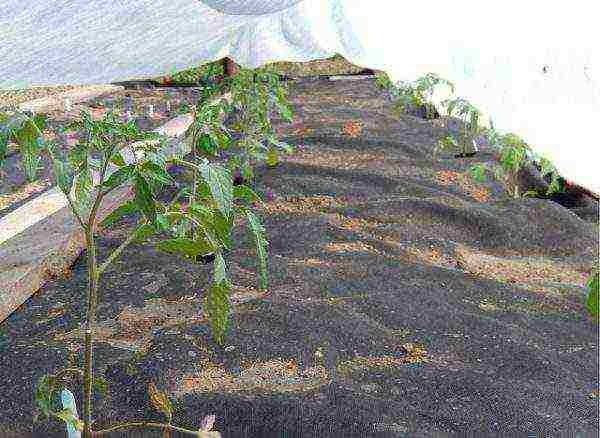 Tomatoes under the covering material
Tomatoes under the covering material
Tomato seedlings are also grown in a seedless way under a covering material or film. As soon as the ground warms up a little, prepare the bed. They loosen the soil, apply fertilizers there, and moisten. Prepared and processed seeds are sown in shallow grooves, by a maximum of 1 cm. The grains are sprinkled with a layer of soil, watered with warm water and covered... As a covering material, you can use agrofiber or polyethylene. In this way, a greenhouse effect is created, in which the soaked grains sprout much earlier.
Sowing seeds is carried out at a sufficient distance from each other, since transplantation with this method is not carried out.
The method of growing under cover material is designed to save time; it is used more in the southern regions and the middle lane.
Bucket growing method
Growing tomatoes in buckets, according to gardeners' reviews, gives significantly higher yields. Experiments in this regard have been repeatedly carried out, which have confirmed this fact. The method is suitable for greenhouse cultivation; in open space, tomatoes do not bear fruit so abundantly.
It is no longer possible to determine exactly who initiated this method of cultivation. They began to use it due to the lack of planting space for grown seedlings.... A mixture of soil from the site and compost is collected in a bucket, a tomato sprout is planted, watered abundantly. Throughout the entire period of growth until fruiting, as it dries, the soil is periodically watered, during the formation of the ovary, watering is increased. The method allows you to significantly extend the fruiting period of any variety, while vegetables can be grown not only in a greenhouse, but also on balconies and loggias.
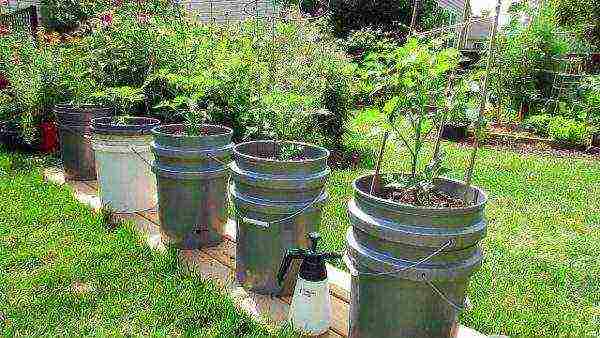 Tomatoes in buckets
Tomatoes in buckets
There is an officially registered method, initially prepared buckets of soil mixture are used for it. It should be noted that according to the recommendations, it is better to dig the container into the ground by 25-30 cm.
With this growing of tomatoes, it is important to carry out a comprehensive feeding of boles three times. Fertilizers in liquid form must be poured directly under the root, it is important to ensure that moisture does not get on the stem and leaves of the plant.
The described methods are recognized as the most common and effective for growing tomatoes in various weather conditions.... Their effectiveness has been confirmed by both novice gardeners and specialists in this business.
You can plant and grow tomatoes and other vegetables under any conditions. This can be done even when there is a catastrophic lack of space on the personal plot or it is absent altogether. To do this, it is enough just to exactly follow all the instructions and tips.
Few people know how to plant tomatoes according to the method of Galina Kizima? But this technology allows you to solve the problem with an insufficient place for growing seeds for seedlings. Galina Kizima has developed many methods of agrotechnical development. She has created a completely new way of growing tomato seedlings in film. As a result, strong plants are obtained, suitable for further planting in open ground.
This method is optimal for those cases when there is a need to prepare a large number of seedlings for the summer season. But the main thing is that this does not require a lot of free space, which is often in short supply.
Advantages and disadvantages of the method
The classic method of growing tomatoes involves sowing seeds in a container with soil. Often pots, glasses and other products are used for this. But, according to the Kizima method, the sowing of seed is carried out in non-woven material. In this case, we are talking about a dense plastic wrap. With its help, a small amount of land is formed, which is enough for growing high-quality seedlings.
The peculiarity of the film container is that it retains moisture, which is so necessary to obtain strong and healthy shoots for seedlings.
Galina Aleksandrovna's method is also called in "diapers" or "in Moscow". This is due to the fact that the inhabitants of this particular city were the first to use the technology. When it came to growing seedlings, many Muscovites faced such a problem as a lack of free space in an apartment. Kizima's method made it possible to easily resolve this issue.
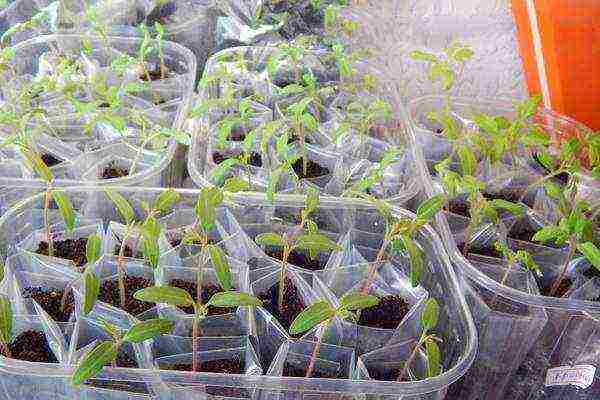
Before planting tomato seeds, it is necessary to carefully study the advantages and disadvantages of the technology. As for the advantages, the author of the technology here draws attention to the following:
- A record number of sprouts can be placed on one windowsill without hassle. This saves space, which is often in short supply.
- Diving of seedlings is carried out quite easily and quickly. To do this, you just need to unfold the "container" and reach the sprout. In the future, they are planted in a prepared container.
- You don't need a lot of land to grow seeds. So, for example, to plant a hundred sprouts, you need no more than 5 kg of soil.
- This growing method helps protect tomatoes from disease. This is especially true for the black leg. The chance of its occurrence is minimized.
- A transparent container makes it easy to check which seeds have sprouted and which ones are just about to germinate.
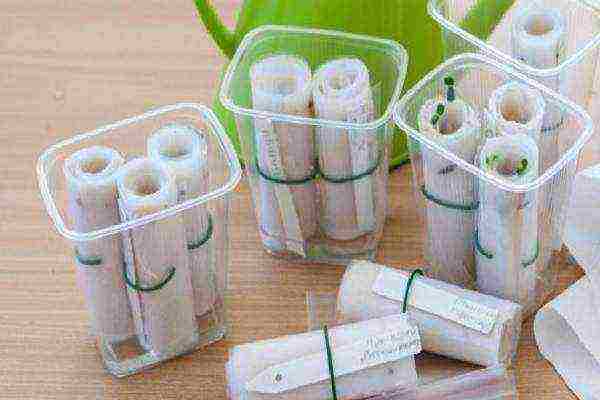
The method from Galina Kizima has many advantages. But, unfortunately, there are several disadvantages here:
- Tomato seedlings do not have enough space for germination. Also, the dense arrangement of "pots" leads to a decrease in natural lighting. All this leads to the fact that the sprouts grow and develop relatively slowly. Therefore, in order to get the material for planting in open ground in time at the beginning of the season, it is necessary to sow the seeds in advance.
- As a result of growing seeds in films, the plant has a strong and stable stem, which cannot be said about the root system. Therefore, when landing in unprotected soil, it is worth taking care of its strengthening.
The Moscow-style method is recommended for cold-resistant plants. This will greatly simplify the cultivation of tomato seedlings. Of course, if necessary, it can be applied in the case of thermophilic plants. But, here it is imperative to dive the sprouts.
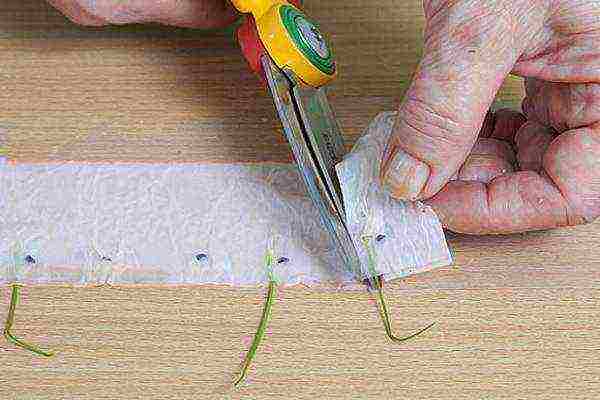
Features of the method
The peculiarity of this technology is that after planting in the soil, tomatoes can grow without water for a long time. Before this, the lower leaves are cut off. Seeds are planted in an oval-shaped hole. It should be so deep that the sprout is halfway in. At the same time, about 6 liters of compost, 200 ml of woody vines and a small pinch of potassium permanganate are added to it. All this is mixed directly in the hole and poured with a bucket of water. Tomatoes are planted only after all the water has been completely absorbed.

At the next stage, the seedlings are buried, and their tops are attached to the peg vertically evenly. It remains only to pour in one more bucket of water and at this the planting of tomato seedlings can be considered finished.
Important: The depth of the shoots should be no more than 5 cm. If you plant the plants deeper, then in the future this will lead to their drying out.
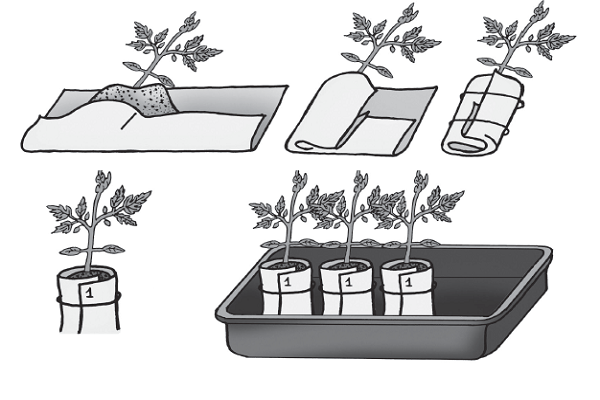
Growing methods
Planting tomatoes according to Galina Kizima's method is performed in several ways. So, germinated and non-germinated seeds are used for cultivation. Also, the process can be carried out on the basis of the substrate. Before sowing tomatoes for seedlings, you must carefully consider all the options offered. It is also worth considering the advice of Galina. This will allow you to grow strong and healthy plants.
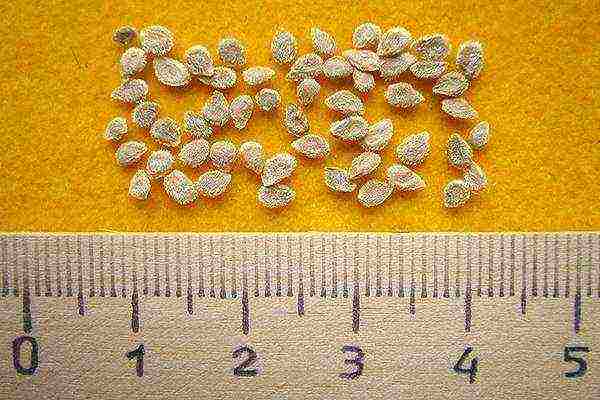
Using germinated seeds
This method is used for sowing tomato seeds. In this case, the seed is prepared in the usual manner. Before sowing, you need to carry out manipulations in this order:
- calibrate;
- disinfected with a special agent;
- soaked in a growth promoter;
- leave for 3 days to wake up.
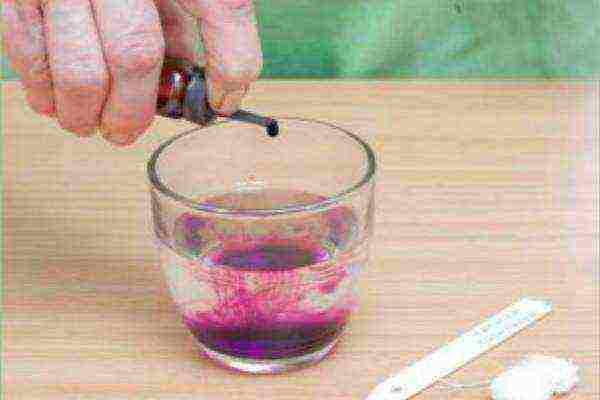
The last stage involves immersing the seeds of seedlings in a napkin, which is pre-moistened with warm water. They are placed under the bag for 3 days. When the first loops appear from the seeds, then you can start planting them. So, how to grow tomato seedlings:
- even squares with a side of 20 cm made of thick film;
- soil that is prepared by itself or purchased in the store;
- rubber;
- seedling.
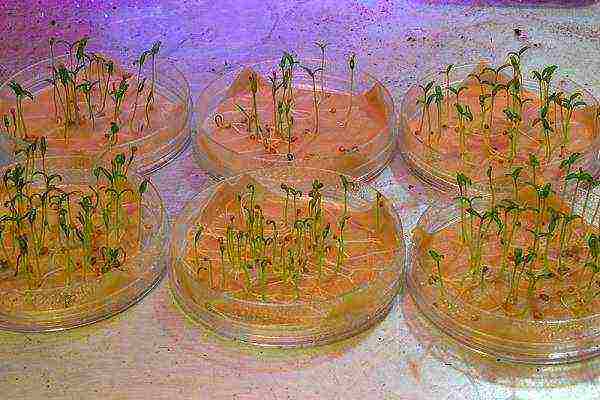
The process of planting seeds is carried out in the following sequence:
- On the corner of the prepared film, the soil is laid out in the right amount. The grown tomato seedlings are gently immersed in it. In this case, the cotyledon leaves should be located above the edge of the film. The root is completely covered with soil.
- The film is folded in the center and wrapped in a roll. To maintain its shape, it is fixed with a bank rubber band.
- All prepared bundles are placed in the pallet. It fits in a well-lit area.
In order not to forget about the landing date, the corresponding marks are made on the film with a marker.
Using dry seeds
To complete the landing, you need to prepare some materials:
- dense polyethylene;
- soil that has the desired composition;
- rubber bands;
- seeds.
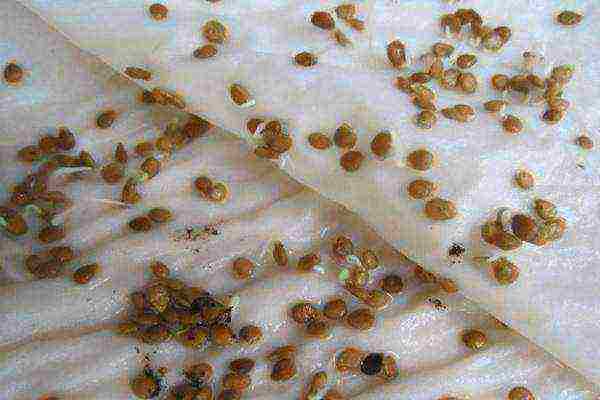
The work is carried out in the following sequence:
- Dense polyethylene is cut into strips 10 cm wide.
- Prepared strips are laid out on the workplace. The earth is poured on them in an even layer. It is thoroughly moistened with water, to which a growth stimulant is added.
- Tomato grains are sown along the strip at a distance of 4 cm from each other.
- The polyethylene is rolled up and fixed with an elastic band.
- A plastic bag is put on the finished roll. After that, they are placed in a box, which is set in a warm place.

When the first shoots appear, the bags are removed from the rolls.In this case, the box is rearranged to a well-lit place. Also, artificial light sources are used for lighting.
Substrate use
In this case, we are talking about using toilet paper. The peculiarity of this material is that it absorbs moisture very well, and then gives it away easily. This allows you to grow a strong and resilient plant.
To complete the landing, you need to prepare the following materials:
- polyethylene of sufficient density or underlay for laminate;
- roll of toilet paper;
- bank gum;
- sprouted tomato seeds.
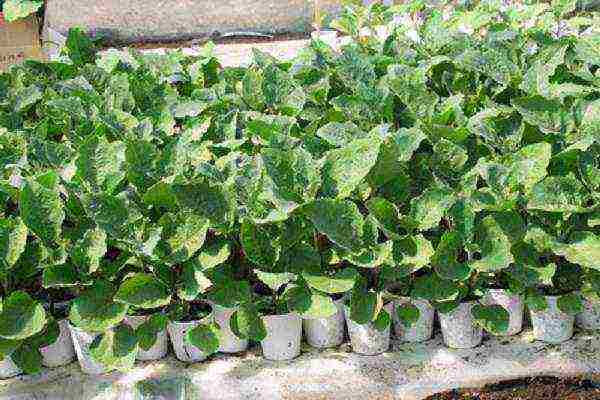
The disembarkation process is carried out in the following sequence:
- The polyethylene is cut into strips 10 cm wide.
- The finished strips are laid out on the table. The strips of paper are stacked in three layers and moistened abundantly. For this, an aqueous solution of a growth stimulant is used.
- We sow tomato seeds on strips of polyethylene at a distance of 4 cm from each other. After that, they are covered with moistened toilet paper. Additionally, the seeds are moistened with a special nutritious liquid.
- At the final stage, the rolls are formed. In this case, it is worth making sure that the seeds do not move. To preserve the shape of the bundle, it is fixed with bank rubber bands.
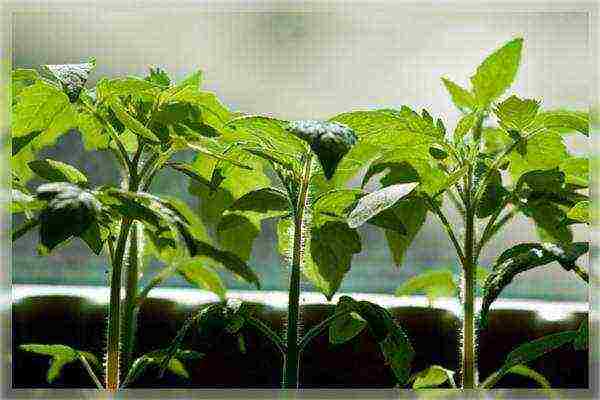
On ready-made "rolls" put on plastic bags. They are then placed in a drawer, which is set in a dark and warm place. It is best to place them near the battery. After the seed has germinated, the bags are removed and the tomatoes are moved to a well-lit area.
Some helpful tips
For growing tomato seedlings, it is better to use seeds of determinant varieties or hybrids. It is better to sow them at the end of March. Since it will take no more than a month and a half to get seedlings, this period is the best solution.
Important: Indeterminate varieties of tomatoes are not suitable for this method, since the formation of brushes is disturbed during the growth process. As a result, it branches into 2 or 3 shoots.
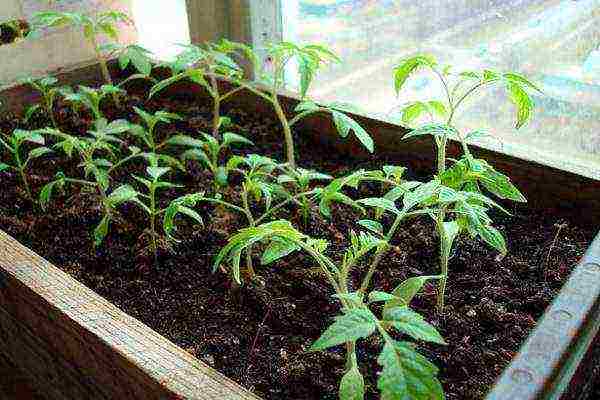
In the process of transportation, tomato seedlings are under severe stress. This is especially true for changes in temperature and humidity levels. Therefore, they should be pre-treated with a small amount of Healthy Garden. This will help protect the growing tomato sprout from negative environmental factors, as well as protect it from the stress that arises from their transportation.
Galina insists that the seedlings are irrigated if necessary. First of all, the soil moisture level is determined. To do this, you need to stick your finger in the bundle. If it remains dry, then the tomatoes need urgent watering.

When growing tomatoes, plant fertilization is equally important. For the first time, fertilizers are applied one and a half weeks after the pick. For this, it is recommended to use a diluted mullein. To prepare a solution, you need to add 1 liter of organic fertilizer concentrate to a bucket of water. It is carefully introduced into the root zone. To do this, use a watering can, which has a thin nose.

There are two categories of extreme gardeners: workaholics and lazy people. For some, everything grows and blooms. They plow day and night, tirelessly with shovels, but this labor feat does not add health to them. Others - seedy parsley with dill in the daytime with fire in the garden, you will not find weeds above their heads, and they are not really worried about it. But there is one more "sort" of summer residents: reasonably lazy. He adheres to the golden mean: he gathers a rich harvest, and does not forget to rest. Galina Aleksandrovna Kizima, famous throughout the country, tells how to become one. In her eighty years, she copes well with the "dacha" worries, and also runs a website, speaks on radio and television.Who, if not her, knows a way to become a reasonably lazy gardener, to harvest a large harvest year after year, without missing out on the opportunity to enjoy summer vacations. Galina Kizima generously shares all her secrets and methods with her readers.
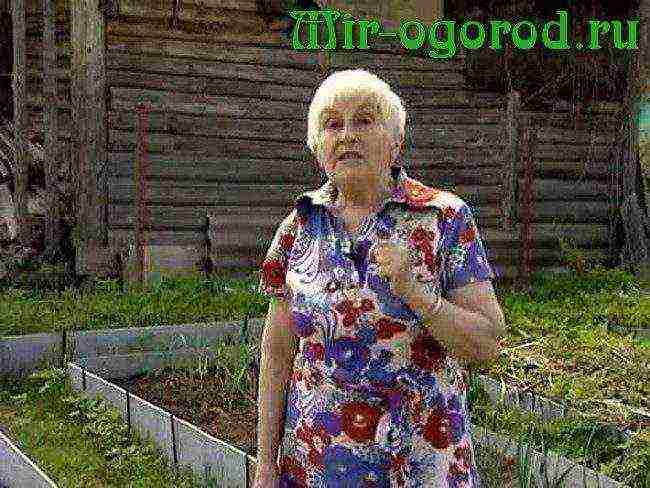
The method of growing tomatoes from Galina Kizima
It has become a familiar picture when summer residents, having arrived at their garden plots on weekends, first of all rush to the greenhouses with a watering can to water the tomatoes. This occupation, especially for the elderly, is quite exhausting, the return in the harvest for this diligence is most often scanty.
Fresh articles about garden and vegetable garden
- Sow tomato seeds 60 days before planting. Previously, no need. Seedlings will appear in about 7-10 days. Immediately start watering not with water, but with a weak solution of mineral fertilizers.
- To preserve the roots, the first transplantation of seedlings (picking) must be done in a diaper made of film. To do this, cut diapers the size of a notebook sheet from an old rather dense film left over from greenhouses or a new film. These films will serve you for many years.
- Stick a piece of adhesive plaster on the upper left corner of the diaper (the roll you bought at the pharmacy will last you a lifetime).
- Pour one tablespoon of the prepared and moistened seedling soil onto the upper left side of the diaper, carefully transfer the seedling to it (remove with a tablespoon). And pour another tablespoon of soil on top. Cotyledonous leaves should be at the very edge, and above 2-3 true ones.
- Bend the bottom edge of the diaper in the same way as a baby is swaddled (leaving some freedom for the legs) and holding the soil with the seedling with your hand, start rolling the cylinder, rolling it to the right. Slip on two elastic bands and close all the seedling rolls in a container large enough to stand upright.
- It should be watered very sparingly, but not with water, but with a weak solution of mineral fertilizer. It is more convenient and better to use liquid fertilizers (only not organic!) With a good composition. For example, Uniflor-bud, Narcissus, any for indoor flowers.
- When the seedlings have 5-6 true leaves, unfold the diapers, add another tablespoon of soil down under the roots and roll up the rolls again, but without bending the bottom edge, put on rubber bands and, holding the soil from below so that it does not fall out, make rolls again into capacity.
- Before transportation to the site, do not water for 2-3 days, the seedlings will stick a little - this is not scary, but it will not be fragile and will not break during transportation. Roll each roll of seedlings into a newspaper and put in a box with a jack.
- Before planting seedlings, water the soil well with Fitosporin plus Gummy.
- When planting seedlings from its lower half, we cut off all the leaves, dig an oblong groove-hole slightly more than half a stem long under the bush.
- Pour half a bucket-bucket of compost into the groove (I prepare the compost without sprinkling its layers with mineral fertilizers, so I put it as needed, without fear of overfeeding), a handful or two of wood ash, 1 gram of potassium permanganate. Mix everything thoroughly. Pour half a bucket of water into the grooves.
- After absorbing moisture, I lay the lower part of the stem strictly horizontally, orienting the tops to the north.
- If we plant seedlings without a clod of earth, then be sure to breed a clay chatterbox by dipping half a stem into it, then powder the coating with dry earth (for better connection with the soil). Sprinkle with a layer of earth 3-5 cm. Tie the upper part of the stem almost at a right angle to the stakes driven in there and then (or later tie it to the trellis). From above we pour another half a bucket of water under the bush, trying to avoid moisture getting on the leaves.
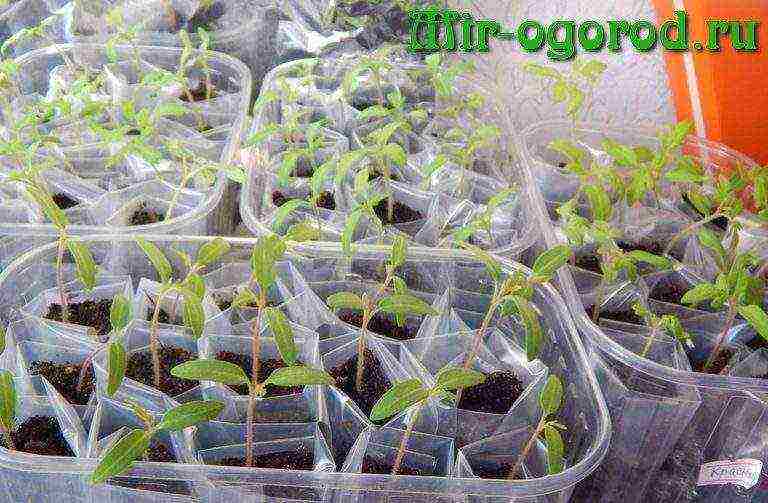
That's all - I don't water the bushes anymore throughout the season, right up to harvest. It should be remembered that if you plant the plants deeper, there will be no effect from planting, since at a depth of 10-15 cm microorganisms are practically absent, and they mainly feed the plant.
Potato growing method from Galina Kizima
Can you grow two crops of potatoes per season? It is possible, says Galina Kizima, if you have a small plot, this will save you a landing area. To do this, at the beginning of March, after processing, cut off the apex from the planting tubers, put them on greening for 20 days and then plant them on seedlings. Keep the remaining parts of the tuber in a cool place (+4 ° C) so that they do not germinate in advance. At the end of April, expose them to the light for greening. After 20-25 days, cut each tuber into three parts so that each part has approximately the same number of sprouts. Plant in seedling boxes. In early May, plant the seedlings grown from the tops on prepared beds with insulated soil under double lutrasil and spud it with a "head". Start dripping large tubers in mid-June. And in late June - early July, remove the entire crop. A bed with early potatoes from the top of the tubers will be released in early July. It can be used for spinach, radish, or late beet seedlings, or sow carrots (they will still have time to grow by the end of October), or sow black radish or lettuce. Or plant winter garlic on it, but not in September - October, but at the end of August, on the 25-26th. It is at the end of August, but there are some nuances, about them in the section on garlic (the fifth year in the garden without difficulty). In early June, after the night frosts have passed, plant the grown potatoes from the main tubers according to the usual pattern 30 × 70 cm, spud well. When planting seedlings, it is necessary to make holes so deep that 3-4 leaves remain above the soil surface, cover the rest of the stem with soil. The planted seedlings must be watered. Harvest for winter storage will be removed from this garden in early September.

The method of growing carrots from Galina Kizima
Galina Kizima has her own interesting farming technique. She is a supporter of easy gardening and uses methods that help her grow vegetables without significant labor costs. Galina Aleksandrovna's vegetable garden lives its own life, everything grows and ripens by itself, she can only collect crops. Everything turns out easily when you know the garden tricks.

Galina Kizima's method for planting carrots does not require furrow preparation and further thinning of seedlings. Carrot seeds are mixed with fertilizer and fine sand. This helps to avoid thickening of the plantings.
Fresh articles about garden and vegetable garden
All this mixture is sown on top of the ground on the garden bed, as if you "salt soup", sprinkle a little and slam. Ready. This method is especially suitable for older people who no longer have the strength to selflessly make furrows and spread seeds.
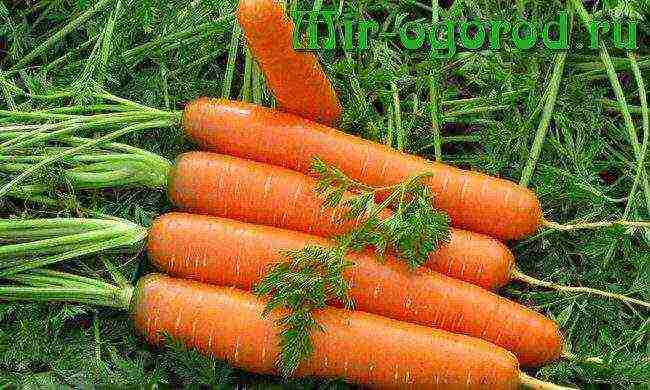
It would seem that everything is very simple, will a capricious carrot really grow after such treatment? Galina shows her garden: it is growing, and how!

